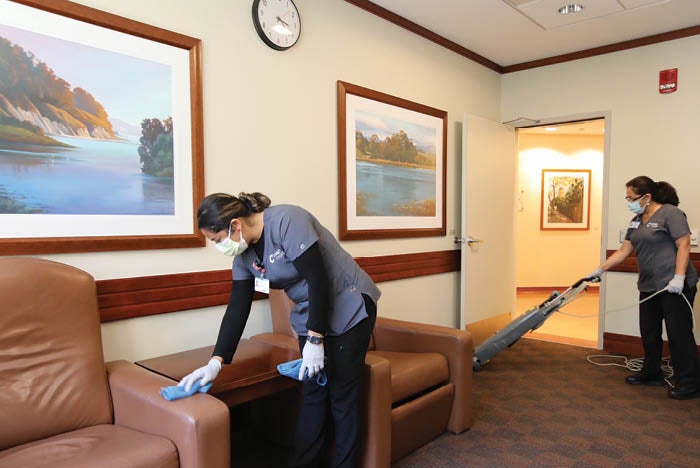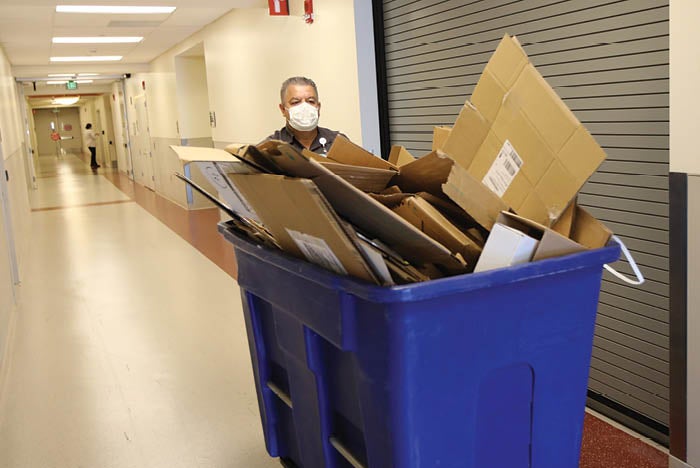Effective management, collaboration and COVID-19 efforts drive performance

FROM LEFT: Silvia Ramirez, EVS supervisor; Raymond Ruiz, T-CSCT, EVS supervisor; Giuseppina (Jo) D’Ambrosio, director of hospitality services; Flavid Montoya, MBA, CHFM, CHESP, EVS manager; Julio Rea, T-CHEST, EVS lead; Fabiola Alvarado, T-CSCT, EVS lead; Alejandro Rosales, EVS lead; Rafael Mendez, EVS supervisor; and Francisco Gomez, T-CHEST, EVS supervisor.
Image courtesy of Santa Barbara Cottage Hospital/Cottage Health
One key indicator of a healthy and productive environmental services (EVS) department is its employee retention rate, which can fluctuate into undesirable levels if personnel aren’t trained properly, managed correctly or appreciated for their efforts. Considering the high demands of this job, particularly during the COVID-19 crisis, turnover is always a concern — but not at Santa Barbara Cottage Hospital, where the retention rate peaked at 94.7% in 2020, a remarkable metric, especially considering the facility’s size and staff (529 beds, 1 million square feet of cleanable area and 151 full-time employees last year).
“In retaining the majority of our employees, we were able to have consistency in our quality of service and had the opportunity to develop our staff. In fact, last year we promoted two front-line employees to lead roles and one of our leads into a supervisor position,” says Flavid Montoya, MBA, CHFM, CHESP, manager of the hospital’s EVS department.
An even greater source of pride for Montoya was the quick flexibility his team demonstrated in responding rapidly to the growing pandemic. All EVS personnel worked and trained inside the hospital’s six COVID-19 cohort units containing more than 100 COVID-19-positive patients at the peak of the pandemic. They learned the doffing and donning requirements to enter units, thoroughly disinfected unoccupied and occupied COVID-19-positive patient rooms, and altered workflows in these units as necessary to meet the demand.
“Our goal was to make sure all EVS personnel had the experience of working in these units and were comfortable and educated regarding their roles during the pandemic. COVID-19 was not going to stop our quality of service; COVID-19-positive patients received the same quality of service from EVS as every other patient,” says Giuseppina (Jo) D’Ambrosio, Santa Barbara Cottage Hospital’s director of hospitality services. “In addition, as protocols changed during the pandemic, EVS worked side by side with nursing and infection control specialists to disseminate the changes and keep everyone informed.”

Armando Ortiz, EVS floor technician, and Octavio Perez, EVS representative, sterilize biowaste with an autoclave sterilizer.
Image courtesy of Santa Barbara Cottage Hospital/Cottage Health
Additionally, as there was a lot of misinformation about the vaccine and COVID-19, “we worked with the employee health and safety department to set up individual meetings with employees who had questions so that they could be better informed,” Montoya says.
These measures helped the hospital to win the Association for the Health Care Environment's (AHE's) Environmental Services Department of the Year Award for 500-plus bed hospitals.
Strength in numbers
But last year’s achievements didn’t stop there. The hospital earned an 82% top box response in HCAHPS survey results for cleanliness of environment — 10% higher than the national average and ranking in the 98th percentile for the 500-plus bed category in 2020. What’s more, environment of care rounds tallied a 95% pass rate, and $103,950 in cost savings was earned through the efforts of the hospital’s quality value analysis team, of which the EVS department is a part.

Daisy Santos and Martha Figueroa, EVS representatives, clean and disinfect a waiting room in a critical care unit.
Image courtesy of Santa Barbara Cottage Hospital/Cottage Health
“In addition, over the past 12 months, we implemented an electrostatic sprayer as part of our secondary disinfection program for more at-risk patients in all critical care units, oncology, renal and discharge/transfer rooms with isolation precautions," Montoya says. "This spraying system is an added measure beyond the standard disinfection best practices.”
To further improve performance, the EVS department relied on software that tracks the productivity of hospital staff and departments, and accurately measures patient room turnaround times and patient discharge times so that staff can be more accurately managed and efficiency can be maximized. This software proved instrumental in reporting monthly turnaround times and helped the EVS team set key metrics goals.
To increase staff engagement, EVS management also used a system of accountability called shared governance, which establishes a positive staff/management partnership and leads to a meaningful, respectful and creative work environment dedicated to meeting the health care needs of all patients served. The hospital’s shared governance committee has EVS representatives from both evening and morning shifts that meet monthly to discuss quality and morale improvement initiatives.
“We are firm believers, as well, in consistent coaching, transparency and taking an assertive approach with our staff and their well-being,” D’Ambrosio says. “If issues arise, we do not let them fester. We train our team players to find a resolution. Building a culture that embraces opinions and is solution oriented takes consistent work, but emphasizing our department’s goal to strive for improvement has paid dividends.”

Elizabeth Bello, secondary disinfection technician, uses an electrostatic sprayer to add a second layer of disinfection in a patient room
Images courtesy of Santa Barbara Cottage Hospital/Cottage Health
Interdepartmental collaboration between EVS and the infection prevention and control (IPC) department has been admirable, too. The two teams consistently work together to maintain levels of quality service, as evidenced by monthly observation of EVS staff performing occupied room cleaning at each campus, unoccupied room terminal cleaning and electrostatic spray disinfection; annual education given on isolation precautions, personal protective equipment (PPE) and hand hygiene during EVS staff meetings; training provided in the moment and education offered during monthly observations; the twice-yearly performing of environment of care rounds on all units; and continually collaborating with IPC to maintain quality control.
As further proof of its diligence, the EVS department includes annual in-services like chemical usage, PPE and isolation precautions, hand hygiene and medical waste; annual cleaning/disinfection observations such as surgical cleaning, occupied rooms and unoccupied rooms; environment of care rounds, during which observations of EVS reps performing hand hygiene and visual inspections of unoccupied rooms are conducted; and quality assurance testing and room inspection performed in patient care areas to ensure quality of disinfection.
Santa Barbara Cottage Hospital also has the honor of being the first hospital in the country to receive the AHE’s Platinum Level Environmental Sustainability Certificate, which demonstrates its accomplishments around sustainable operations and environmental sustainability and highlights the EVS department’s value in achieving organizational goals.

Marcos Perez, EVS representative, transports material from sterile processing to a cardboard compactor.
Images courtesy of Santa Barbara Cottage Hospital/Cottage Health
Among its accomplishments: 35% to 40% of waste is diverted from landfills (about 60 tons monthly, including 4,000 pounds of plastic); the hospital’s blue wrap program recycles the clean sterile blue wrap in its procedure areas (32.4 cubic tons recycled in 2020 alone); 4,000 pounds of kitchen food scraps are composted monthly; the nutrition department endorses the use of locally sourced food in its cafeteria and hosts a farmer’s market every Wednesday; and sharps containers are reused safely up to 500 times.
Recognition matters
“We are extremely proud of our commitment to quality and the structures we’ve set in place to uphold this commitment. Our department’s success is a byproduct of how our team carries itself and demonstrates the empowerment our staff has to be leaders,” Montoya says. “Studies show that nearly two in three American workers do not feel valued in their work, but our department bucks that trend, striving to promote the values we all share here.”
D’Ambrosio says everyone on the team is honored to be recognized by AHE as an EVS Department of the Year. “Our staff is committed to being a leading-edge EVS department and maintaining high levels of performance in disinfection, infection control and prevention, customer service and environmental sustainability,” she says.



